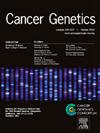评估ClinVar中SMARCB1变异分类的一致性和基因型-表型关系的断言
IF 2.1
4区 医学
Q4 GENETICS & HEREDITY
引用次数: 0
摘要
致病性SMARCB1变异与多种孟德尔综合征相关:神经鞘瘤病(SM)、横纹肌样肿瘤易感性综合征(RTPS1)和/或Coffin-Siris综合征(CSS)。尽管一些数据表明基于突变类型和位置的基因型/表型关系,但由于表型数据不一致或缺失,这可能无法一致使用。我们使用最大的变体分类公共平台ClinVar来评估来自临床实验室和引用出版物的变体特异性数据,以评估报告的一致性和基因型-表型关系。如果可以,我们提取突变类型、HGVS命名法、提交者、出版物和疾病状况。我们将实验室提交的疾病断言与引用出版物中的疾病断言进行了比较。在59个SMARCB1致病变异中,我们确定了91个实验室提交的报告(38个单一实验室和20个多实验室)和40篇被引用的文章。在91份意见书中,40份没有提供任何疾病断言。无义RTPS1变异(n = 23)主要位于外显子2,部分位于外显子1、4和5,其他变异类型仅限于帧移和大量缺失/重复。在SMARCB1中发现SM变异(n = 10),具有不同的变异类型。CSS变异(n = 6)是单氨基酸缺失、错义和移码变异,仅限于外显子8和9。尽管ClinVar是一个丰富的变异数据来源,并广泛用于变异分类,但经常缺乏疾病断言和不一致的报告阻碍了SMARCB1明确基因型-表型关系的实现。鉴于这些诊断的重大临床影响,需要一种更标准化的方法来报告与多种孟德尔疾病相关的疾病的致病变异。本文章由计算机程序翻译,如有差异,请以英文原文为准。
Evaluating the consistency of SMARCB1 variant classification and assertions of genotype-phenotype relationships in ClinVar
Pathogenic SMARCB1 variants are associated with multiple Mendelian syndromes: Schwannomatosis (SM), Rhabdoid Tumour Predisposition Syndrome (RTPS1), and/or Coffin-Siris Syndrome (CSS). Although some data suggests genotype/phenotype relationships based on mutation type and location, this is not used consistently potentially due to inconsistent or absent phenotypic data. We used ClinVar, the largest public platform of variant classifications, to evaluate variant-specific data from clinical laboratories and cited publications to assess reporting consistency and genotype-phenotype relationships. When available, we extracted the mutation type, HGVS nomenclature, submitters, publications, and disease conditions. We compared the disease assertions made by laboratory submissions with those made in cited publications. Across 59 SMARCB1 pathogenic variants, we identified 91 laboratory submissions (38 single and 20 multiple laboratories) and 40 cited articles. Of 91 submissions, 40 did not provide any disease assertion. Nonsense RTPS1 variants (n = 23) were mostly located in exon 2, with some in exons 1, 4 and 5, and other variant types were limited to frameshifts and large deletions/duplications. SM variants (n = 10) were found throughout SMARCB1 with diverse variant types. CSS variants (n = 6) were single amino-acid deletions, missense and frameshift variants limited to exons 8 and 9. Although ClinVar is a rich source of variant data and extensively used during variant classification, the frequent absence of disease assertions and inconsistent reporting impedes implementation of clear genotype-phenotype relationships for SMARCB1. Given the significant clinical impact of these diagnoses a more standardized way of reporting pathogenic variants for diseases associated with multiple Mendelian disorders is needed.
求助全文
通过发布文献求助,成功后即可免费获取论文全文。
去求助
来源期刊

Cancer Genetics
ONCOLOGY-GENETICS & HEREDITY
CiteScore
3.20
自引率
5.30%
发文量
167
审稿时长
27 days
期刊介绍:
The aim of Cancer Genetics is to publish high quality scientific papers on the cellular, genetic and molecular aspects of cancer, including cancer predisposition and clinical diagnostic applications. Specific areas of interest include descriptions of new chromosomal, molecular or epigenetic alterations in benign and malignant diseases; novel laboratory approaches for identification and characterization of chromosomal rearrangements or genomic alterations in cancer cells; correlation of genetic changes with pathology and clinical presentation; and the molecular genetics of cancer predisposition. To reach a basic science and clinical multidisciplinary audience, we welcome original full-length articles, reviews, meeting summaries, brief reports, and letters to the editor.
 求助内容:
求助内容: 应助结果提醒方式:
应助结果提醒方式:


